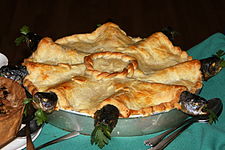
A pie is a baked dish which is usually made of a pastry dough casing that contains a filling of various sweet or savoury ingredients. Sweet pies may be filled with fruit, nuts, fruit preserves, brown sugar, sweetened vegetables, or with thicker fillings based on eggs and dairy. Savoury pies may be filled with meat, eggs and cheese or a mixture of meat and vegetables.

A pasty is a British baked pastry, a traditional variety of which is particularly associated with Cornwall, South West England, but has spread all over the British Isles, and elsewhere through the Cornish diaspora. It is made by placing an uncooked filling, typically meat and vegetables, in the middle of a flat shortcrust pastry circle, bringing the edges together in the middle, and crimping over the top to form a seal before baking.
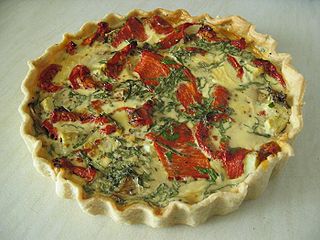
Quiche is a French tart consisting of pastry crust filled with savoury custard and pieces of cheese, meat, seafood or vegetables. A well-known variant is quiche Lorraine, which includes lardons or bacon. Quiche may be served hot, warm or cold.

Mousehole is a village and fishing port in Cornwall, England, UK. It is approximately 2.5 miles (4 km) south of Penzance on the shore of Mount's Bay. The village is in the civil parish of Penzance. An islet called St Clement's Isle lies about 350 metres (380 yd) offshore from the harbour entrance.
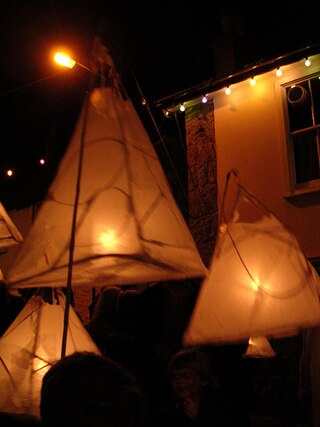
Tom Bawcock's Eve is an annual festival, held on 23 December, in Mousehole, Cornwall.

Picrous Day was a festival celebrated by the tin miners of Cornwall on the First Thursday before Christmas. This is believed to be the feast of the discovery of tin by a man named Picrous whom miners in the East of Cornwall celebrated as the founder of their industry instead of St Piran.
Nickanan Night is a Cornish feast, traditionally held during Shrovetide, specifically on Shrove Monday.
Tom Bawcock is a legendary character from the village of Mousehole, Cornwall, England. He appears to have been a local fisherman in the 16th century. According to the legend, one winter had been particularly stormy, meaning that none of the fishing boats had been able to leave the harbour. As Christmas approached, the villagers, who relied on fish as their primary source of food, were facing starvation.
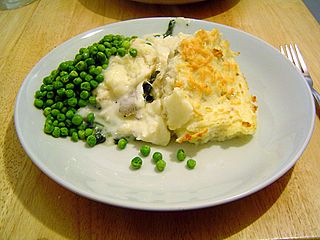
Fish pie, also known as fisherman's pie, is a traditional British dish.
Troyl is a colloquial Cornish word meaning a barn dance or céilidh, a social evening of dance, music and song.

Cornish mythology is the folk tradition and mythology of the Cornish people. It consists partly of folk traditions developed in Cornwall and partly of traditions developed by Britons elsewhere before the end of the first millennium, often shared with those of the Breton and Welsh peoples. Some of this contains remnants of the mythology of pre-Christian Britain.

Timballo is an Italian baked dish consisting of pasta, rice, or potatoes, with one or more other ingredients included. Variations include the mushroom and shrimp sauce timballo Alberoni, named after Giulio Alberoni, and the veal and tomato sauce timballo pattadese.
Huff paste is a cooking technique involving making a stiff pie shell using a mixture of flour, suet, and boiling water. The pastry when cooked creates a tough protective layer around the food inside. When cooked, the pastry is generally discarded as it is virtually inedible. However, the shell becomes soaked with the meat juices and historically was sometimes eaten by house servants after the meal had concluded.

Fishing in Cornwall, England, UK, has traditionally been one of the main elements of the economy of the county. Pilchard fishing and processing was a thriving industry in Cornwall from around 1750 to around 1880, after which it went into an almost terminal decline. During the 20th century the varieties of fish taken became much more diverse and crustaceans such as crab and lobster are now significant. Much of the catch is exported to France due to the higher prices obtainable there. Though fishing has been significantly damaged by overfishing, the Southwest Handline Fishermen's Association has started to revive the fishing industry. As of 2007, stocks were improving. The Cornwall Sea Fisheries Committee is one of 12 committees responsible for managing the corresponding Sea Fisheries District. The Isles of Scilly Sea Fisheries Committee is responsible for the Scilly district.

Cornish cuisine encompasses the cooking styles, traditions and recipes associated with Cornwall and the Cornish people. It has been heavily influenced by the geography of the county as well as its social history.

Squab pie is a traditional dish from South West England, with early records showing it was associated with Cornwall, Devon and Gloucestershire. Although the name suggests it contains squab, in fact it contains mutton and apples. The pie was eaten around the world in the 1900s, though outside South West England it generally did contain pigeon.
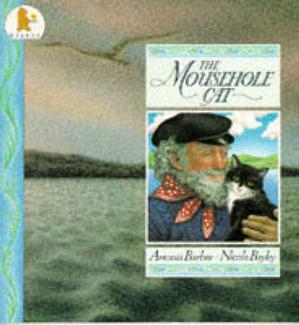
The Mousehole Cat is a children's book written by Antonia Barber and illustrated by Nicola Bayley. Based on the legend of Cornish fisherman Tom Bawcock and the stargazy pie, it tells the tale of a cat who goes with its owner on a fishing expedition in rough and stormy seas. The book has won awards, including the 1998 British Book Award for Illustrated Children's Book of the Month. It has since been adapted into a 1994 animated film, a puppet show and is being adapted as a stage musical.

Sardines ("pilchards") are a nutrient-rich, small, oily fish widely consumed by humans and as forage fish by larger fish species, seabirds and marine mammals. Sardines are a source of omega-3 fatty acids. Sardines are often served in cans, but can also be eaten grilled, pickled, or smoked when fresh.
Lamprey pie is a pastry dish made from sea lampreys or European river lampreys. Lampreys were a delicacy for the wealthy in medieval England and were often given as gifts to royalty as a means of seeking favour. It became tradition for the city of Gloucester to give the monarch a lamprey pie each Christmas. In 1200 the city was fined 40 marks for failing to provide the pie. The annual custom ended in 1836 but a pie is still presented on special occasions such as coronations and jubilees.
